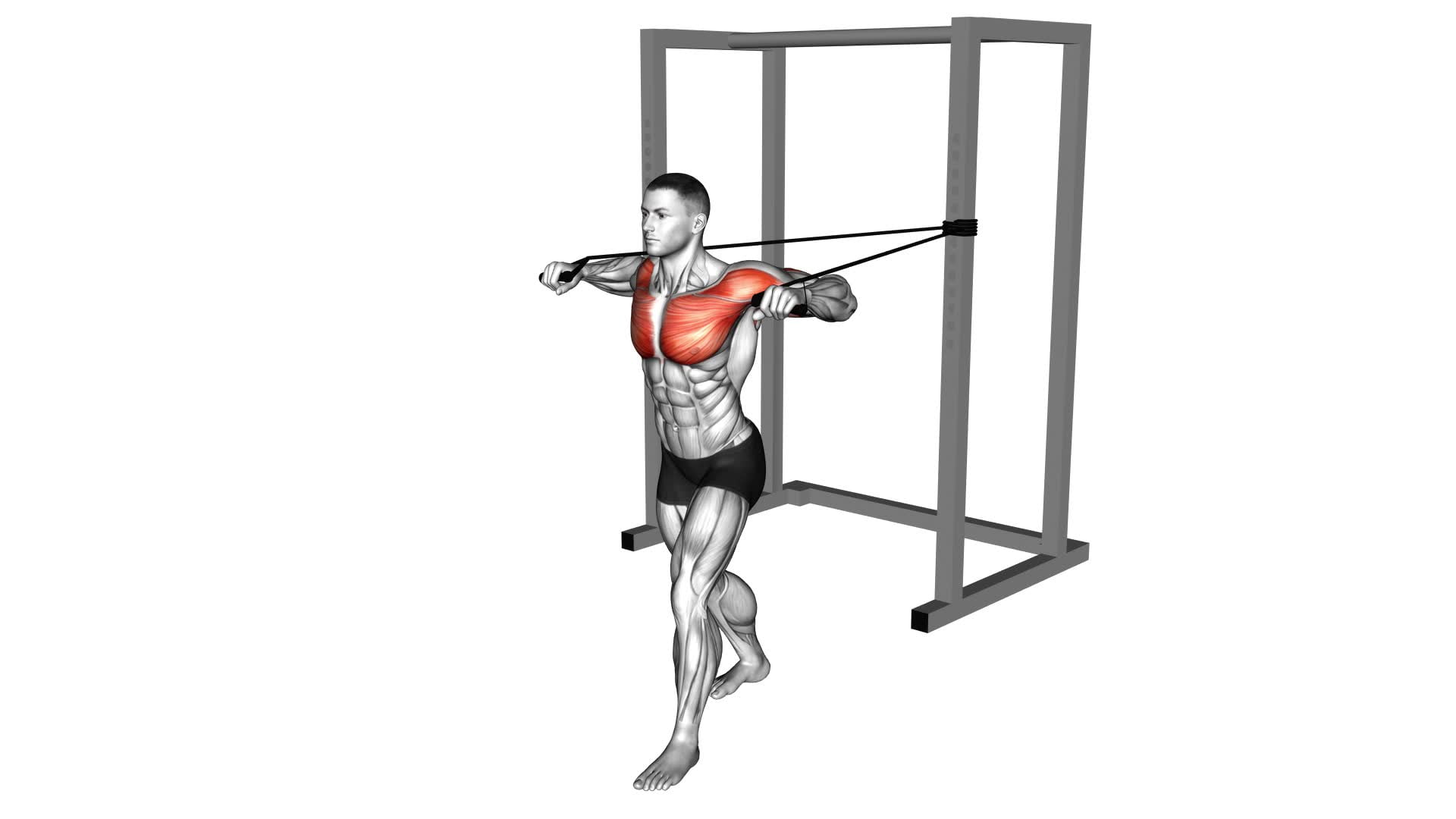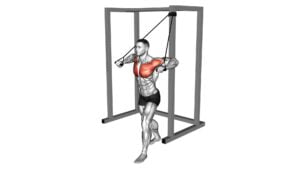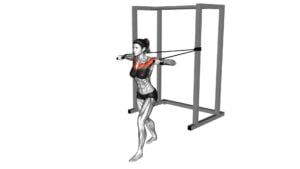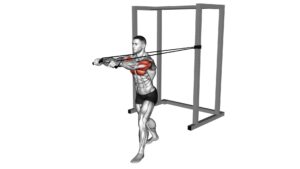Band Standing Alternate Chest Press (male) – Video Exercise Guide & Tips

Are you looking to strengthen your chest muscles with an effective exercise? Look no further than the Band Standing Alternate Chest Press.
Watch This Exercise Video
This exercise targets your pectoral muscles while also engaging your core and stabilizer muscles. By using resistance bands, you can easily adjust the intensity to suit your fitness level.
In this video exercise guide, we'll walk you through the proper form and technique, as well as provide tips to help you get the most out of this exercise.
Let's get started!
Key Takeaways
- The Band Standing Alternate Chest Press targets the pectoralis major muscles for a well-defined chest.
- Proper form and technique, such as aligning elbows with shoulders and squeezing chest muscles together, are crucial for effective targeting and strengthening of the chest muscles.
- Engaging the core muscles and maintaining a controlled pace are important for stability and to prevent strain or injury.
- Choosing the right resistance band, starting with a lighter one and progressively increasing resistance, is essential for challenging the muscles effectively and preventing strain or injury.
Benefits of the Band Standing Alternate Chest Press
Experience the advantages of the Band Standing Alternate Chest Press for a stronger and more defined chest. This exercise offers numerous benefits that can help you achieve your fitness goals.
Firstly, the Band Standing Alternate Chest Press targets the pectoralis major muscles, which are responsible for the movement of your arms towards the center of your body. By engaging these muscles, you can develop a more powerful and well-defined chest.
Additionally, the use of resistance bands in this exercise provides constant tension throughout the movement. This constant tension increases the demand on your chest muscles, leading to greater muscle activation and growth.
The Band Standing Alternate Chest Press also requires stability and balance, as you need to maintain a controlled motion while standing on one leg. This engages your core muscles, contributing to overall strength and stability.
To perform the Band Standing Alternate Chest Press correctly, start by attaching the resistance bands to a stable anchor point. Stand with one foot in front of the other, gripping the bands with your palms facing down. Alternate pressing one arm forward, while keeping your core engaged and maintaining a slight bend in your elbows. Focus on a slow and controlled motion, emphasizing the contraction of your chest muscles.
Proper Form and Technique for the Exercise
To perform the Band Standing Alternate Chest Press with proper form and technique, it's important to focus on correct body alignment. Keep your feet shoulder-width apart, engage your core, and maintain a neutral spine throughout the exercise.
Correct Body Alignment
To achieve proper form and technique for the Band Standing Alternate Chest Press exercise, ensure that you maintain a straight and aligned body position throughout the movement. Proper body alignment techniques and maintaining proper posture are crucial for maximizing the effectiveness of this exercise and preventing injuries. Here are three important points to remember:
- Stand with your feet shoulder-width apart and your knees slightly bent. This will provide a stable base and help you maintain balance during the exercise.
- Keep your spine straight and your core engaged. Avoid arching or rounding your back, as this can put unnecessary stress on your spine.
- Maintain a neutral head position by looking straight ahead. Avoid tilting your head up or down, as this can strain your neck and affect your overall form.
Engaging Chest Muscles
To engage your chest muscles properly in the Band Standing Alternate Chest Press exercise, maintain proper form and technique by keeping your elbows aligned with your shoulders throughout the movement.
Engaging your chest muscles is crucial for effective chest exercises. By aligning your elbows with your shoulders, you ensure that the tension is placed directly on your chest muscles, maximizing their activation.
As you press the bands forward, focus on squeezing your chest muscles together and feeling the contraction. This will help to target and strengthen your chest effectively.
Engaging your chest muscles properly in this exercise won't only enhance your overall chest development but also reduce the risk of injury.
Now that you understand how to engage your chest muscles, let's move on to avoiding common mistakes in the Band Standing Alternate Chest Press exercise.
Avoiding Common Mistakes
Make sure you maintain proper form and technique to avoid common mistakes in the Band Standing Alternate Chest Press exercise. By following these guidelines, you can reduce the risk of injury and maximize your results:
- Keep your core engaged: Engaging your core muscles throughout the exercise not only helps stabilize your body but also prevents excessive strain on your lower back.
- Maintain a controlled pace: Avoid using momentum or jerking movements to press the bands. Instead, focus on controlled and smooth motions to target your chest muscles effectively.
- Use appropriate resistance: Select a band with resistance that challenges you but still allows you to maintain proper form. Using a band that's too heavy can lead to compromised technique and potential injury.
Choosing the Right Resistance Band for Your Fitness Level
When choosing a resistance band for your fitness level, there are several points to consider.
First, band tension and progress should be taken into account. As you become stronger, you may need to increase the resistance of the band to continue challenging your muscles.
Additionally, your fitness level should be considered when selecting a band, as different bands offer varying levels of resistance. It's important to choose a band that provides enough resistance to effectively work your muscles without causing strain or injury.
Band Tension and Progress
Choose a resistance band that matches your fitness level to ensure proper band tension and progress during the Band Standing Alternate Chest Press exercise. Band tension is crucial for achieving optimal results and avoiding injury. Here are three key factors to consider when selecting the right resistance band:
- Resistance Level: Opt for a band with enough resistance to challenge your muscles without compromising form. Start with a lighter band and gradually increase the resistance as you get stronger.
- Band Length: Make sure the band is long enough to allow for a full range of motion during the exercise. It should provide enough tension throughout the movement, but not be too tight or restrictive.
- Material and Durability: Choose a high-quality band made from durable materials that can withstand frequent use. This ensures longevity and reliable resistance for tracking progress over time.
Fitness Level Considerations
To ensure you choose the right resistance band for your fitness level, consider your current strength and select a band that provides enough challenge without compromising form. Fitness modifications are essential for injury prevention and ensuring a safe and effective workout.
If you're a beginner or have limited strength, start with a lighter resistance band and gradually increase the tension as you build strength. Intermediate exercisers can opt for a medium resistance band, while advanced individuals may require a heavy band to provide enough resistance for optimal muscle stimulation.
It's essential to listen to your body and make adjustments accordingly. Remember, the goal is to challenge yourself without overexerting or risking injury. By selecting the appropriate resistance band, you can customize your workout and achieve your fitness goals effectively.
Choosing Appropriate Resistance
Consider your current strength and select a resistance band that provides enough challenge without compromising form to ensure you're choosing the appropriate resistance for your fitness level.
Here are three key factors to consider when selecting the right resistance band:
- Progression options: Look for a resistance band that offers a range of resistance levels or can be easily adjusted. This will allow you to gradually increase the intensity of your workouts as your strength improves. Having the ability to progress ensures that you continue to challenge your muscles and make consistent gains.
- Selecting appropriate equipment: Take into account your current fitness level and goals when choosing a resistance band. If you're a beginner or have limited strength, start with a lighter resistance band and gradually work your way up. On the other hand, if you're more advanced, opt for a band with higher resistance to provide the necessary challenge.
- Consider your exercise repertoire: Think about the specific exercises you plan to do with the band. Different resistance bands may be better suited for certain exercises. For example, some bands are designed for upper body exercises, while others are better for lower body workouts. Choosing the right band for your intended exercises will ensure optimal results.
Variations and Progressions to Challenge Yourself
To further challenge yourself, try incorporating variations and progressions into your Band Standing Alternate Chest Press routine.
By introducing different variations, you can target specific muscle groups and add complexity to your workout.
One variation you can try is the Single Arm Band Chest Press. Instead of using both arms simultaneously, this exercise focuses on one arm at a time, providing a unilateral challenge.
Another variation is the Band Push-Up. By placing the resistance band across your back and securing it with your hands, you can perform a push-up while adding resistance to the movement. This variation engages your chest muscles in a different way and increases the difficulty of the exercise.
To progress your Band Standing Alternate Chest Press, you can gradually increase the resistance of the band. Start with a lighter band and progressively work your way up to a heavier resistance as your strength improves. This will continue to challenge your muscles and help you build strength over time.
Remember to always maintain proper form and technique throughout your exercises to prevent injury and maximize results.
Common Mistakes to Avoid During the Exercise
When performing the Band Standing Alternate Chest Press, be careful to avoid these common mistakes:
- Improper Breathing: Many people tend to hold their breath or breathe inconsistently during the exercise. This can lead to decreased performance and potential dizziness. Remember to inhale deeply before initiating the movement and exhale forcefully as you press the bands away from your chest. Proper breathing not only enhances your overall performance but also helps stabilize your core and maintain focus.
- Lack of Shoulder Stability: Neglecting proper shoulder positioning can result in injuries. Avoid allowing your shoulders to roll forward or shrug up towards your ears. Instead, engage your shoulder blades by pulling them down and back, creating a stable base for the movement. This won't only prevent shoulder injuries but also enhance the effectiveness of the exercise by targeting the chest muscles more effectively.
- Overloading the Resistance: It may be tempting to use heavier resistance bands than you can handle, but this can lead to compromised form and an increased risk of injury. Start with lighter resistance and gradually increase the intensity as your strength improves. Remember, it's better to focus on proper form and technique rather than lifting heavier weights.
Tips for Incorporating the Band Standing Alternate Chest Press Into Your Workout Routine
To make the most out of the Band Standing Alternate Chest Press in your workout routine, focus on maintaining proper form and incorporating variations to target different areas of your chest muscles.
Here are some tips to help you incorporate this exercise effectively:
- Start with proper form: Stand with your feet shoulder-width apart, and hold the resistance band handles at chest level with your palms facing down. Keep your core engaged and your back straight throughout the movement.
- Control the movement: Slowly extend one arm forward while keeping the other arm bent at the starting position. Avoid jerking or swinging the band, and maintain a controlled motion throughout the exercise.
- Alternate sides: Alternate between extending your left and right arm to work both sides of your chest evenly. This helps to improve balance and prevent muscle imbalances.
- Vary the resistance: Use different resistance bands or adjust the tension of the band to challenge your chest muscles at different levels. Gradually increase the resistance as your strength improves.
Benefits of incorporating the Band Standing Alternate Chest Press into your workout routine include improved chest strength, enhanced muscle symmetry, and increased stability in your upper body.
Remember to consult with a fitness professional to ensure proper technique and to tailor the exercise to your individual needs and goals.
Frequently Asked Questions
How Often Should I Perform the Band Standing Alternate Chest Press Exercise?
To get the most out of the band standing alternate chest press exercise, it's important to consider the frequency. The frequency of this exercise depends on your fitness goals and current level of strength. However, performing this exercise 2-3 times a week is generally recommended.
The benefits of the band standing alternate chest press include increasing chest and shoulder strength, improving stability, and enhancing overall upper body muscle development.
Remember to consult with a fitness professional for personalized guidance.
Can I Perform This Exercise if I Have Shoulder or Chest Injuries?
If you have shoulder or chest injuries, modifications can be made to the Band Standing Alternate Chest Press exercise. It's important to prioritize your safety and avoid aggravating your injuries.
Consult with a healthcare professional or a qualified fitness trainer to determine the appropriate modifications for your specific condition. They can provide you with alternative exercises or adjustments to the form and intensity of the exercise to accommodate your injuries and facilitate proper healing.
Is It Necessary to Warm up Before Doing the Band Standing Alternate Chest Press?
Before performing the band standing alternate chest press, it's essential to warm up your muscles. Incorporating warm-up exercises before strength training can help increase blood flow, improve flexibility, and reduce the risk of injury.
Common mistakes to avoid while performing this exercise include using too much resistance, not maintaining proper form, and not breathing properly.
How Long Should I Hold the Contraction at the Peak of the Movement?
To maximize your gains, it's crucial to know how long to hold the contraction at the peak of the movement. Holding the contraction in resistance training is beneficial as it increases muscle fiber recruitment and enhances muscle strength.
However, the exact duration may vary depending on your fitness level and goals. Remember to maintain proper breathing technique during weightlifting to optimize your performance and avoid unnecessary strain.
Consult with a fitness professional for personalized guidance.
Can I Use Dumbbells Instead of Resistance Bands for This Exercise?
Yes, you can use dumbbells instead of resistance bands for the Band Standing Alternate Chest Press exercise. Dumbbells offer several benefits for the chest press, including the ability to increase weight incrementally and target specific muscle groups with more precision.
They also provide a more stable grip, allowing for better control during the exercise. Incorporating dumbbells into your workout routine can help you achieve greater strength and muscle development in your chest muscles.
Conclusion
Incorporating the Band Standing Alternate Chest Press into your workout routine offers numerous benefits, including increased chest and shoulder strength. By maintaining proper form and technique, and choosing the right resistance band for your fitness level, you can effectively target these muscle groups.
Additionally, incorporating variations and progressions can help you challenge yourself and continue to see progress. Avoiding common mistakes will ensure you get the most out of this exercise.
Start incorporating the Band Standing Alternate Chest Press into your routine for a stronger upper body.

Author
Years ago, the spark of my life’s passion ignited in my mind the moment I stepped into the local gym for the first time. The inaugural bead of perspiration, the initial endeavor, the very first surge of endorphins, and a sense of pride that washed over me post-workout marked the beginning of my deep-seated interest in strength sports, fitness, and sports nutrition. This very curiosity blossomed rapidly into a profound fascination, propelling me to earn a Master’s degree in Physical Education from the Academy of Physical Education in Krakow, followed by a Sports Manager diploma from the Jagiellonian University. My journey of growth led me to gain more specialized qualifications, such as being a certified personal trainer with a focus on sports dietetics, a lifeguard, and an instructor for wellness and corrective gymnastics. Theoretical knowledge paired seamlessly with practical experience, reinforcing my belief that the transformation of individuals under my guidance was also a reflection of my personal growth. This belief holds true even today. Each day, I strive to push the boundaries and explore new realms. These realms gently elevate me to greater heights. The unique combination of passion for my field and the continuous quest for growth fuels my drive to break new ground.



